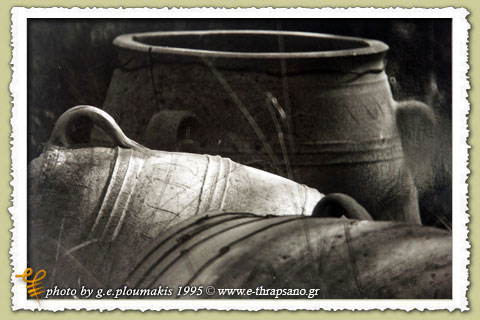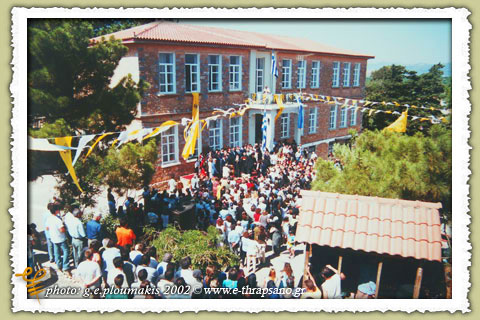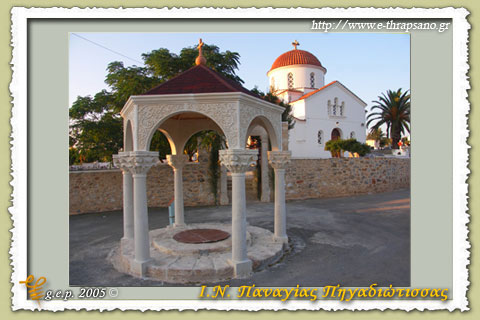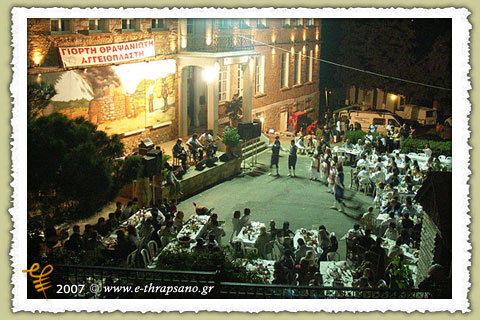
The small reservoir of Livada is located 800 meters north of the village of Thrapsano.
Local people used to exploit clay from the area and thus a pond was created; this pond was enlarged and transformed to the reservoir of Livada. Today the reservoir covers an area of 21.000sq.m. and stores approximately 210.000 cub.m. of water. There is a seasonal change in the water level.
AVI FAUNA: Little Egret, Little Bittern, Night Heron, Snipe, Wood Sandpiper, Moorhen, Black-winged Stilt, Little Stint, Common Sandpiper, Scops Owl, Red-rumped Swallow, Sedge Warbler, Great Reed Warbler, Whiskered Tern, White-winged Black Tern, Ruff, Glossy Ibis, Alpine Swift.
 REST FAUNA: Cretan marsh frog (Rana cretensis), Common tree frog (Hylaarborea), Green toad (Bufo viridis), Striped-Turtlenecked terrapin (Mauremys rivulata),Turkish Gecko (Hemidactylus turcicus), Balkan Green Lizard (Lacerta trillineata)Occelated Skink (Chalcides occelatus), Balkan Whip Snake (Coluber gemonensis), Leopard Snake (Elaphe situla), Dice Snake (Natrix tessellata), Cat Snake (Telescopusfallax), Badger (Meles meles), Weasel (Mustela nivalis), Beech Marten (Martes foina), Eastern Hedgehog (Erinaceus concolor), Leser white toothed Shrew (Crocidura suaveolens), Pygmy white toothed Shrew (Suncus etruscus), Brown hare (Lepus europaeus), Wood Mouse (Apodemus sylvaticus), House Mouse (Mus musculus), Black Rat (Rattus rattus).
REST FAUNA: Cretan marsh frog (Rana cretensis), Common tree frog (Hylaarborea), Green toad (Bufo viridis), Striped-Turtlenecked terrapin (Mauremys rivulata),Turkish Gecko (Hemidactylus turcicus), Balkan Green Lizard (Lacerta trillineata)Occelated Skink (Chalcides occelatus), Balkan Whip Snake (Coluber gemonensis), Leopard Snake (Elaphe situla), Dice Snake (Natrix tessellata), Cat Snake (Telescopusfallax), Badger (Meles meles), Weasel (Mustela nivalis), Beech Marten (Martes foina), Eastern Hedgehog (Erinaceus concolor), Leser white toothed Shrew (Crocidura suaveolens), Pygmy white toothed Shrew (Suncus etruscus), Brown hare (Lepus europaeus), Wood Mouse (Apodemus sylvaticus), House Mouse (Mus musculus), Black Rat (Rattus rattus).
 FLORA: The intense mankind activities as well as the great rise and fall of water level have caused the lack of well-developed hygrophyte societies. At the west side of the reservoir in silty grounds with periodic water coverage we meet species as Cyperus fuscus and C. Longus that go with species as Mentha plegium,Plantago lanceolata, Scirpoides holoschoenus και Heliotropium supinum. At the most open areas we meet annual species as Echium plantagineum, Galactites tomentossum,Cynodon dactylon, Ater squamatus, Lythrum junceum, Bellis perennis, Solanum nigrum, Dittrichia graveolens. There is a shrubby area with Tamarisk trees at the south side of the reservoir. From the rest species the most characteristic ones are: Echium plantagineum, Mentha pulegium, Plantago lanceolata.
FLORA: The intense mankind activities as well as the great rise and fall of water level have caused the lack of well-developed hygrophyte societies. At the west side of the reservoir in silty grounds with periodic water coverage we meet species as Cyperus fuscus and C. Longus that go with species as Mentha plegium,Plantago lanceolata, Scirpoides holoschoenus και Heliotropium supinum. At the most open areas we meet annual species as Echium plantagineum, Galactites tomentossum,Cynodon dactylon, Ater squamatus, Lythrum junceum, Bellis perennis, Solanum nigrum, Dittrichia graveolens. There is a shrubby area with Tamarisk trees at the south side of the reservoir. From the rest species the most characteristic ones are: Echium plantagineum, Mentha pulegium, Plantago lanceolata.
source: Nature History Museum of Crete - N.H.M.C.














